Attractive in all four seasons thanks to blooms and berries, firethorn bush has a lot to offer. But beware: It boasts thick, stiff branches that are covered in thorns. (For protection, find the best gardening gloves for the whole family.) Some gardeners use firethorn as a barrier shrub for privacy but, luckily, the thorns won’t keep birds, bees and other pollinators from stopping by. The shrub can be trained to grow up a wall.
Check out 7 backyard birds that eat berries.
How to Grow a Firethorn Bush

- Pyracantha
- Zones 5 to 10
- Full sun to part shade
- Size: 6 to 15 feet tall and wide
Easily adaptable to many conditions, firethorn offers year-round interest. Enjoy the beauty of its white flowers in spring and orange fruits from fall through winter.
Before planting, check whether the shrub is invasive in your area. Choose one that is resistant to fire blight.
A firethorn bush will grow up to 15 feet high and wide, although dwarf varieties like Red Elf are available.
Check out the top 10 small shrubs for small spaces.
Firethorn Bush Wildlife Benefits

Birds such as cedar waxwings are attracted to the shrub’s orange and red fruits (which look like berries but are actually pomes). If birds ingest overripe fruits, they may act strangely and almost appear intoxicated but this is not harmful. In winter, birds also use the branches as shelter, and in spring and summer they build nests among the glossy foliage.
If you’re looking for bee-friendly cultivars, give Golden Charmer and Orange Glow a try.
See more of our top picks for trees and shrubs with berries for birds.
Berries Provide Winter Interest
The colorful berries of firethorn add a welcome pop of color in fall and winter, and the glossy green leaves stay evergreen in more mild climates. This shrub is an especially nice choice for winter container gardens.
Woody plant expert Michael Dirr says it best: “For fruit display in the winter garden, few plants rival pyracanthas.”
Next, follow these tips for protecting shrubs in winter.

Propagating succulents from stem or leaf cuttings is an easy way to share plants or expand your own collection, says Aaron Ryan, director of inventory at Devil Mountain Wholesale Nursery in Petaluma, California. You can propagate succulents year-round, but it’s easiest during warm, humid months. Follow Aaron’s tips on how to propagate succulents from stems or leaves.
Important note: Patented plants should not be propagated; it may be illegal to create new cuttings. Patent fees support breeders and their work to create new plants.
Psst—learn how to propagate more plants easily.
On This Page
How to Propagate Succulents: Gather Supplies First
When it comes to tools, the most important thing is to sterilize them. “Make sure you’re not using dirty tools, because it’s very easy to pass bacteria or viral infection from one plant to another,” Aaron says.
Don’t be nervous—Whether you use a bonsai knife, Japanese snips or clippers, clean your tools and wipe them with isopropyl alcohol before cutting. You’ll also need clean pots, open flats or liner trays with drainage holes, and succulent potting soil.
Check out the top 10 plants to propagate that grow from cuttings.
Make the Cut
You can root a stem of any size from a multi-branching succulent, Aaron says. Make a cut right below a growth node and strip off extra leaves, leaving two or three at the top. “You need some leaves for the plant to feed itself, but unnecessary leaves might take energy away from the rooting process,” he says.
Stick the cut end 1 to 2 inches into a porous, fast-draining soil mix that can dry quickly. “You never want to have wet feet with succulents; they will rot,” he adds. Compress the soil so the cutting stands upright.
Learn how to grow and care for haworthia succulents.
Peel a Leaf

A few leaves can produce many succulent rosettes, Aaron says. Select thick, healthy leaves near the base. Detach them carefully and completely by grasping each leaf where it meets the stem and peeling it downward.
“If you just rip it off, you’ll lose all the marrow stem tissue and the leaf will rot away,” he says.
Set the detached leaves flat on the surface of a damp bed of 75% perlite and 25% ground-up fir bark, redwood bark or peat. Sometimes, you’ll get two or three rosettes from one leaf.
Check out the top 10 colorful succulents you should grow. Plus, learn what this gardener wishes she’d known before planting her succulent garden.
Find the Right Location
Cuttings root better in bright, airy and humid spots away from direct sunlight or heat. Rooting time depends on the species but might begin after two weeks. After about four weeks, pull gently on your cutting to see if it has rooted. You will have a fully rooted cutting to transplant into a 4-inch pot or a 1-gallon container within five weeks, Aaron says.
Try one of these low-light houseplants in a dark corner of your home.
Water Just the Right Amount

Cuttings need regular moisture until they grow roots, but be sure you are not overwatering. “The key is to water infrequently but deeply,” Aaron says. “Let the soil approach dryness between watering.”
Once fully rooted, succulents store water in their roots, stems and leaves, making them drought-tolerant plants.
Watch for Pests When Propagating Succulents
Take cuttings from your healthy plants only. Good airflow helps prevent infestations of mealybugs and fungus gnats, Aaron says.
“Mealybugs are really detrimental to succulents, causing deformation of the leaves. And with young plants, you have to be especially vigilant about keeping them away,” Aaron says.
Have Fun Experimenting
“Propagating is like mad science; it’s so fun,” Aaron says. “Once you get good at propagating from succulent cuttings, try your hand at woody perennials and softwood and hardwood cuttings. Succulents are a great way to learn.”
About the Expert
Aaron Ryan works as the director of inventory at Devil Mountain Wholesale Nursery in Petaluma, California. He has a bachelor’s degree in biology and history from the University of California-Santa Cruz. Aaron previously worked as the assistant curator at the UC-Santa Cruz Arboretum.
With flowers of almost every color, except blue, roses are one of the most versatile flowering plants in terms of the variety of color that they bring. They’re also the birth flower for the month of June. But, have you ever wondered what your favorite color rose signifies? Learn more about rose color meanings.
Red Roses
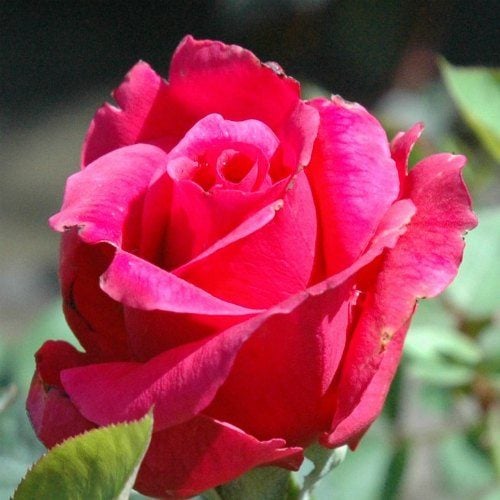
Red roses are one of the most popular ways to say “I love you.” Their deep red color also means courage and passion. My favorite rose bush for the garden is ‘Mr. Lincoln’, which grows tall and produces copious amounts of very fragrant, deep red, blossoms.
Check out 18 fragrant roses to perfume your garden.
White Roses
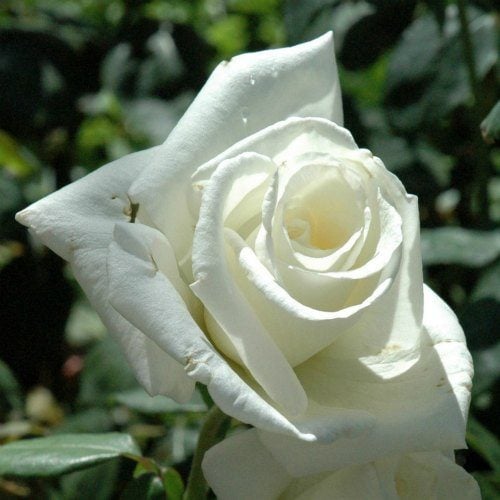
A gift of white roses means innocence, purity or sympathy. When used in bridal bouquets, they signify happy love. I have grown several varieties of white roses, and my favorite is ‘Pristine’, which has beautifully shaped blossoms.
Discover 8 surprising facts about roses.
Yellow Roses
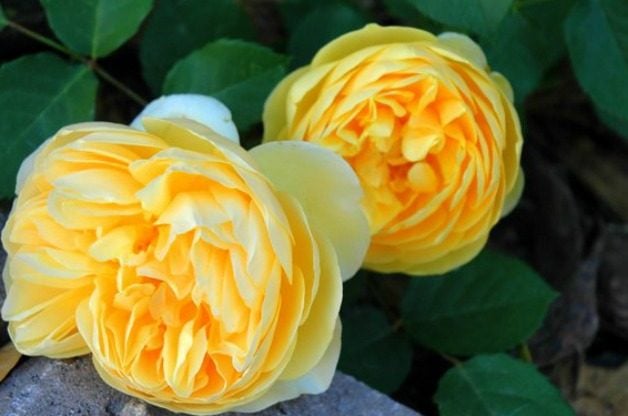
Yellow roses can brighten up any day and signify friendship. There two types of yellow roses that I enjoy growing — ‘Rio Samba,’ which is a hybrid tea rose and ‘Graham Thomas’, which is a David Austin shrub rose that is extremely fragrant.
This rugosa rose deserves lots of love.
Peach Roses
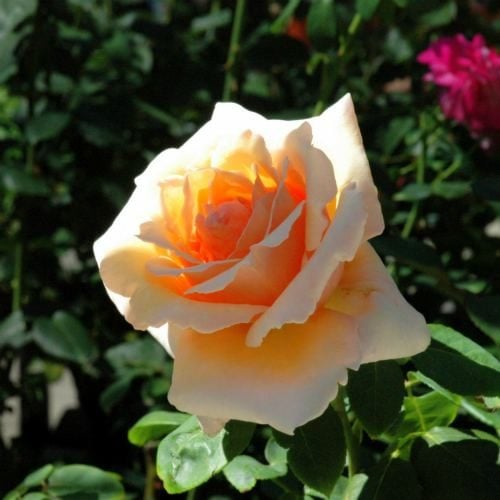
The pastel shades of peach roses are often given as a sign of appreciation or gratitude. ‘Medallion’ and ‘Brandy’ hybrid tea varieties produce beautiful peach blooms.
‘Citrus Splash’ is the gorgeous multicolored rose you need in your garden.
Light Pink Roses
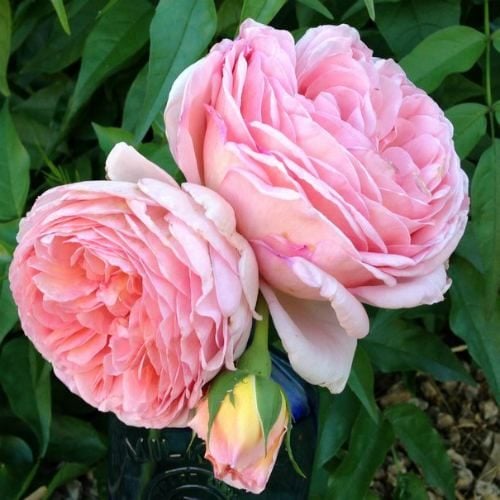
Light pink roses can be used to communicate a variety of emotions including grace, joy and admiration. I enjoy growing the highly fragrant ‘Abraham Darby’, which is another David Austin shrub rose. ‘Bewitched’ is my favorite hybrid tea light pink rose.
Red and White Roses
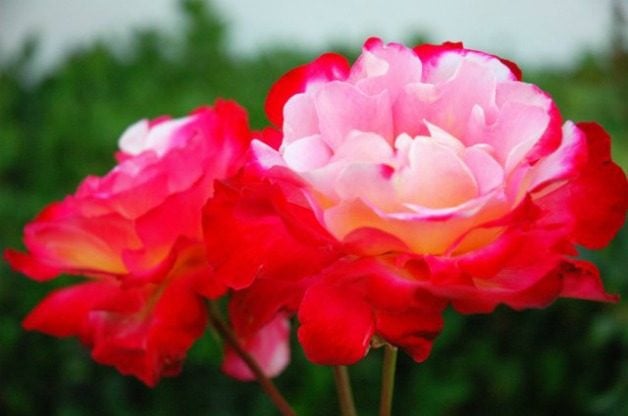
Bi-colored roses also have special meanings, like the red and white roses of ‘Double Delight’, which symbolize unity.
Other Rose Color Meanings
Colorful roses signify the following emotions:
- Dark Pink rose – Thank You
- Orange rose – Desire, enthusiasm
- Coral rose – Desire
- Lavender rose – Love at first sight
Whether you give a gift of roses from your garden or from the florist, there is a rose color meaning that can express the emotions you wish to communicate.
If you’ve had the same bird feeding habits for years, now’s the time to mix it up and try something new. Here are five different ways to bring new birds to your backyard.
Check out the 10 types of bird feeders you need in your backyard.
Try Spreadable Suet Dough

Most bird feeding folks have a suet feeder or two in their yards to attract woodpeckers. But suet has come a long way in recent years. Go beyond the bulky blocks in cage feeders and try the new suet doughs on the market. These can be spread directly on tree trucks or other surfaces, upping your feeder space without adding more feeders. Try a spreadable suet that contains insects or berries to attract a wider variety of birds. You can also offer bite sized suet nuggets on a tray or platform feeder or place suet plugs into a log feeder.
Check out 8 common questions about suet for birds.
Switch to Safflower Seed
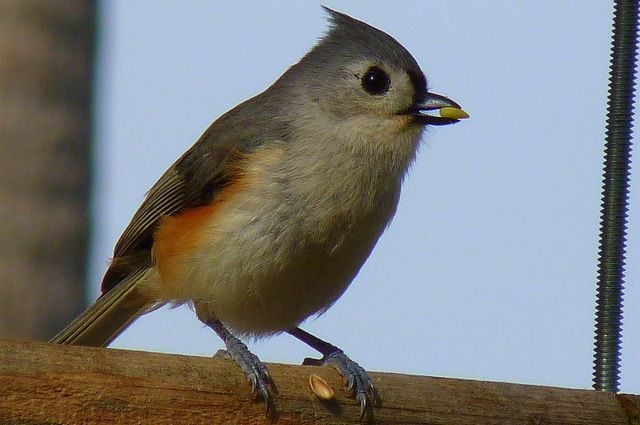
Tired of squirrels stealing all your sunflower seed before the birds even find it? You might want to try safflower seed instead. Most backyard birders find that squirrels don’t seem to like it. Safflower seed may cut down on the variety of birds you see at your feeders, so try mixing it with sunflower seed, or change out just one of your seed feeders.
We found the best squirrel proof bird feeders and 12 tips that work.
Feed Cracked Corn, Not Bread, to Ducks
Love feeding stale bread to ducks at your local pond? While it’s a fun bird feeding activity, it turns out bread is not that healthy for ducks. Instead, mimic their natural diet with cracked corn. They’ll enjoy it just as much, and it provides nutrition they actually need.
Check out 9 foods you should never feed to birds.
Remember Ground-Feeding Birds

Ducks aren’t the only birds that feed on the ground. Many other birds, like cardinals, juncos and grosbeaks, also prefer to dine down below. You can sprinkle seeds directly on the ground. Try it after a fresh snowfall and watch the flocks appear. Bird feeders made especially for ground use are available too. If you worry about predators like cats attacking ground-feeding birds, try installing platform feeders on poles instead. These feeders will attract many of the same birds.
What can birds eat from the kitchen?
Treat Birds to Fruit and Nuts
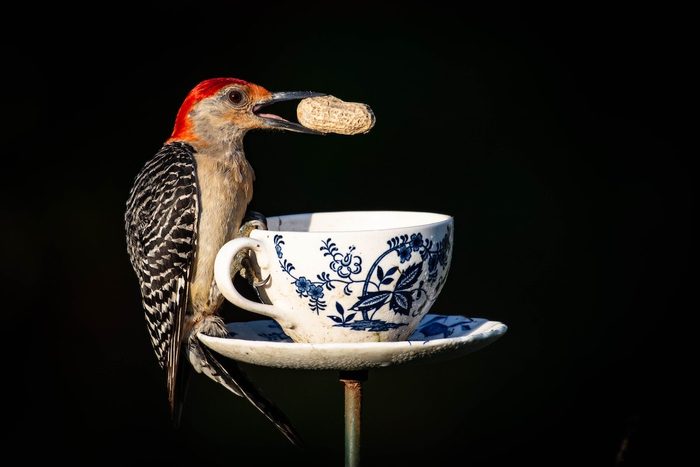
Want to see a feeding frenzy? Try offering dried fruit and nuts from time to time throughout the winter. Birds that don’t usually visit feeders will make exceptions for these yummy tidbits. Peanuts in the shell are favorites for blue jays (and can keep them away from other feeders), and waxwings and flickers love dried cranberries.
If you love to watch these furry critters in your yard, you need to know fun facts about squirrels. Learn how fast squirrels run, how high they can jump and more.
Squirrels Steal Food From Each Other
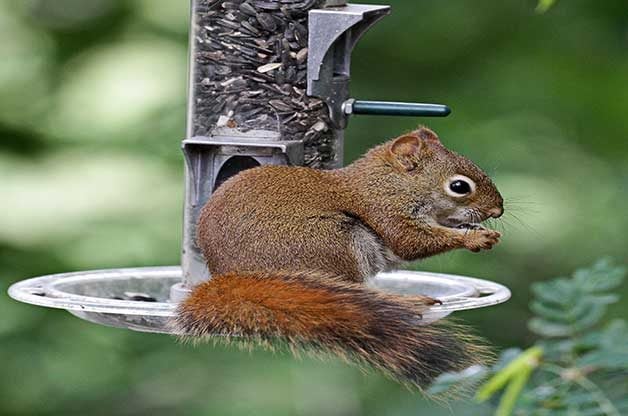
Squirrels are known for constantly foraging and hoarding food… and for stealing! They lose 25 percent of their food to theft by birds and other squirrels.
Check out the best squirrel proof bird feeders and 12 tips that work.
Enjoy a Special Squirrel Holiday

Celebrate furry friends on January 21: National Squirrel Appreciation Day.
We found 13 funny squirrel pictures you need to see. Plus, check out these 15 fun squirrel gifts for squirrel lovers.
Squirrels in the Big Apple

A handful of these mischievous creatures was first released in 1877 in New York’s Central Park, where the population has since flourished.
Do safflower seeds deter squirrels?
Squirrel Top Speed

Squirrels are surprisingly fast; at top speed, they can run 20 mph.
Check out 7 top-rated bird feeder squirrel baffles.
Squirrel Feet Are Surprisingly Flexible

More fun facts about squirrels — they really should get an action movie deal. Their superhero-like talent to reach seemingly inaccessible bird feeders comes from the ability to rotate their hind feet 180 degrees.
Learn what to feed squirrels (and how to peacefully co-exist). Plus, discover how to tell 5 types of squirrels apart.
Not All Squirrels Are the Same Species

There are 285 squirrel species around the world and three over-arching kinds: ground, tree and flying.
Check out our review of the Squirrel-Buster Plus bird feeder.
How High Can Squirrels Jump?

Most gray squirrel types can pull off an 8-foot jump from a stationary position.
Find out how to create the ultimate backyard wildlife habitat.
Squirrel Teeth Keep Growing

A squirrel’s four front teeth grow about 10 inches a year. (Gnawing keeps them short.)
Next, learn how to make a DIY squirrel feeder.
What Does a Baby Chickadee Look Like?

When they’re just born, baby chickadees don’t have the birder-favorite gray, white and black plumage. At first, they’re featherless and pink, then they grow dark feathers, and then, finally, the baby birds start sporting their usual colors.
You might not see a baby chickadee until it’s at your feeder with a parent. To boost your chances of attracting a chickadee family, put up nest boxes. Some chickadees nest in birdhouses, so keep an eye on them! Other chickadees opt instead to build their nests and lay bird eggs in old woodpecker holes or even in cavities in rotting stumps.
You need to see these 20 incredibly cute pictures of chickadees.

“Chickadees are a personal favorite of mine. They are very social, and they wait every morning for me to fill the feeders. I love the way the baby chicks (above) flutter in hopes of being fed. A small part of life’s precious nature,” Birds & Blooms reader Laura Reich says.
Learn how to identify a Carolina chickadee.
What Do Juvenile Chickadees Look Like?

For the most part, juvenile chickadees resemble their brave, friendly parents (who look identical regardless of whether they’re male or female, at least to human eyes). By the time they’re a little less than two weeks old they look like adults, but they remain dependent on their parents for food. This can result in some pretty adorable scenes at your feeders, as the youngsters accompany their parents and beg for a meal.
“While I was sitting one afternoon on my back patio, a family of chickadees came to use my running stream. This hatchling (above) had found one of its parents and was begging for something to eat. You can almost hear the conversation,” Birds & Blooms reader Tara Steffen says.
Psst—meet the too-cute black-capped chickadee and the mountain chickadee.

A few weeks after they leave the nest, the fledglings are able to fly longer distances and feed themselves, so they’re out on their own in the world.
Next, learn how to identify baby and juvenile orioles.

Attracting birds in winter is easier than you might think! The most straightforward advice on how to attract winter birds is to provide foods they love and offer them safe places for them to take shelter as the air gets crisp and the temps fall. Birds are even more beautiful in the midst of a few flurries, so besides helping them get through winter, you’ll also be able to enjoy their beauty in your own backyard.
Feeder activity isn’t always consistent throughout the year. You may notice an uptick in guests in the winter, because a lot of natural food is frozen or hidden under blankets of snow. Birds are generally less territorial in the nonbreeding season, too, so they are more tolerant of sharing space at the feeder. So it’s time to top off the seed supply, pour yourself a cup of hot cocoa, and enjoy the snow birds with these top tips and tricks for winter bird-watching.
Don’t miss the 51 best winter bird photos.
Focus on Feeders

Many birds grow extra down feathers in winter. The puffed-up feathers provide insulation against the elements. Yet winter is still a battle for survival for birds. Feeders with high-fat foods such as suet and peanuts give feathered friends a boost. Woodpeckers are especially fond of these calorie-rich treats, so to attract birds to your yard, consider a double suet feeder or one with a long tail prop that allows them to use their tails as a tripod as they feed. Planting native berry bushes also provides much-needed nutrients for many species as winter settles in.
Discover the truth about 12 winter bird myths and facts.
Provide Fresh Water
Water is an especially attractive offering that will attract birds during the colder months. Adding a heater keeps your bird bath from icing over, giving birds a dependable place to drink (although they won’t use it like a birdie hot tub to warm up). Beyond the backyard, natural areas with open water are magnets for birds in winter. Congregations of waterfowl flock to large rivers and coastal areas. Use your car as a portable blind while you scope for large groups of cold-tolerant ducks, geese and swans.
How do hummingbirds survive snow and cold weather?
Add Roosting Boxes
Bird boxes are often associated with the nesting season, but nuthatches, chickadees, wrens and others will utilize them as roosting sites in the winter. Roosting boxes provide sheltered spots that are warmer than the bone-chilling outside air. Natural shelters, such as cavities in dead or living trees and dense thickets of conifers, can give a similar refuge to smaller birds such as tiny northern saw-whet owls.
Wait for Blustery Days

A bird’s diet is mostly from natural sources, such as berries, seeds and nuts, even when food is scarce. But blizzards and winter storms often bring visitors to feeding stations. To attract birds, bundle up and top off your feeders repeatedly after bad weather. The easy access to a birdseed buffet after a storm provides some of the best bird-watching opportunities. For example, flocks of grosbeaks might ignore feeders much of the season, but they tend to show up during the worst weather. Providing additional feeding stations can help accommodate these occasional large flocks.
Go for a Drive
Some of the best birding can happen from the comfort of your car. Roll your windows down and crank your heaters up. After the autumn leaves fall, the open canopy makes spotting wildlife a bit easier. Look for owls and hawks in the treetops as you cruise the back roads. Migrants that breed on the tundra, from longspurs to snowy owls, often find winter refuge along plowed fields and roadside ditches. Snow buntings will mix in with flocks of horned larks, too.
Welcome Snow Birds

Even in the northern reaches of the continent, winter brings new migrants. Dark-eyed juncos, for example, are exclusively winter backyard visitors for many folks who like to attract birds. These sparrow relatives are predominantly ground feeders, but they also eat from platform trays and fly-through feeders. Look for streaked pine siskins among goldfinches—they’ll blend into the goldfinches wearing their more drab winter feathers. The anticipation of irruptive migrants is another winter highlight—you never know if it will be the year a redpoll shows up in your neighborhood.
Where do hummingbirds migrate in winter?
Go Birding for a Good Cause
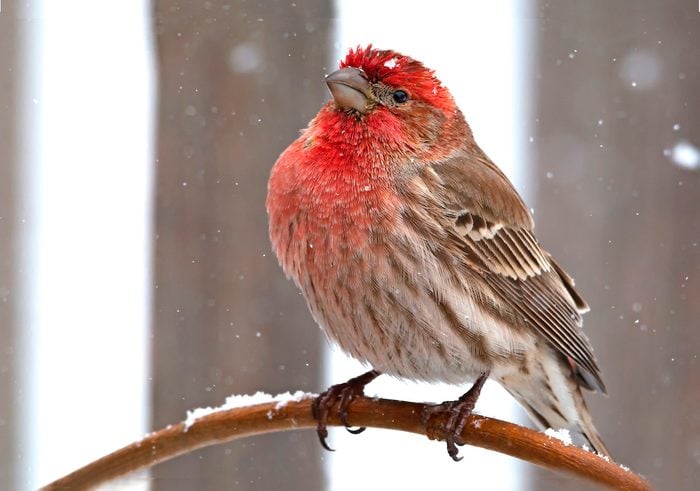
Get involved with a community science project. Project FeederWatch runs from November to April. You can count the birds in your own yard or another designated location. The Audubon Christmas Bird Count is also wonderful for the camaraderie, in addition to being one of the longest-running citizen science programs. Or opt for the Great Backyard Bird Count, an annual fourday event held each February. Beyond data collection, many of these events hold online photo contests and offer other ways to get involved and interact with fellow winter bird-watchers.
6 More Ways to Attract Winter Birds
1. Find the Right Feeder Spot: To get the most winter bird traffic, place feeders at varying heights and locations.
2. Get Crafty: Make a wreath or small container garden and decorate it with birds’ favorite foods.
3. Record It: Keep a bird journal. Jot down important details when you spot a new species.
4. Be Messy: Birds appreciate a little garden debris, like seed-pods, leaf piles and fruit that fell from trees.
5. More Seed!: An extra large tray or hopper feeder holds more seed, which means you’ll fill it less often. It’s a win-win!
6. Think Shelter: Place feeders near trees and shrubs so birds can take shelter from predators.
If you’d like to learn more about attracting birds in winter (and throughout the other three seasons), we highly recommend the book The Joy of Bird Feeding: The Essential Guide to Attracting and Feeding Our Backyard Birds by Jim Carpenter. This book is the ultimate resource for backyard birders and includes what are the best foods to offer for the specific birds you want to see, how to deter unwanted backyard guests (like squirrels), and practical tips for identifying and attracting birds.
Readers Share the Joys of Winter Birding
Our readers shared some of their best photos, and we’ve included a tip on how to attract these birds to your backyard in winter.
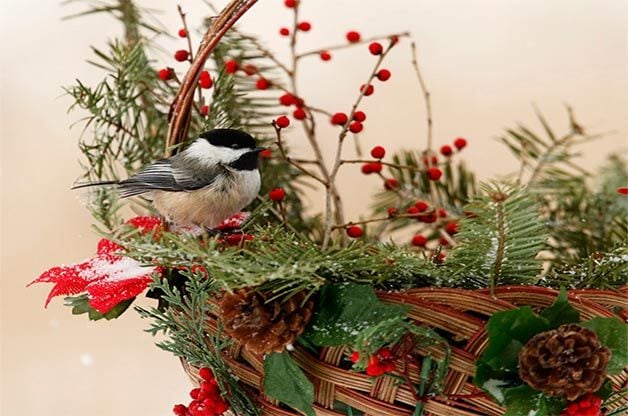
1. Black-Capped Chickadee
A black-capped chickadee posed on a festive basket that I made last winter. —Respah Mitchell of Exeter, Maine
Attract with: willow, alder and birch trees for nesting and suet, sunflower seeds, peanuts at hanging feeders and window feeders
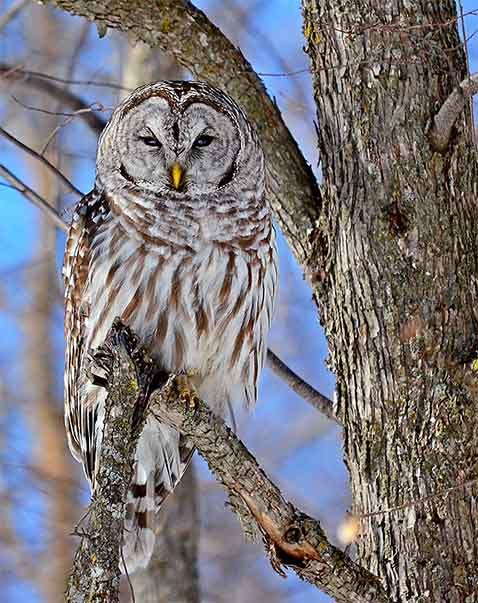
2. Barred Owl
This barred owl came to our yard for a few days last winter and hunted some of the red squirrels. I was able to get kind of close to it as it perched in this tree. Unfortunately, two days after I captured this shot, I found the bird next to a snowbank. I feel this photo is something of a memorial to it. —Laurie Painter of Silver Cliff, Wisconsin
Attract with: nest boxes in mature, dense trees
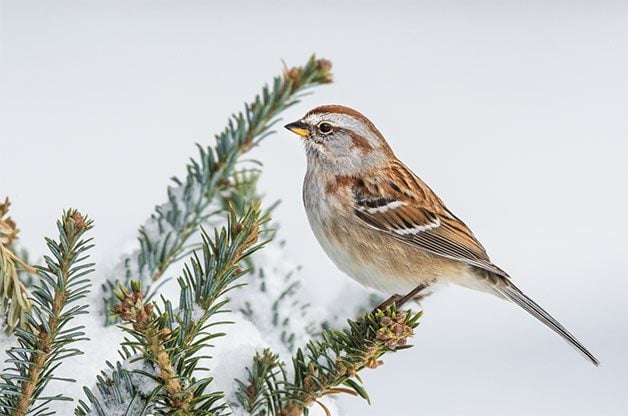
3. American Tree Sparrow
Some days, the winter skies are drab and full of snow clouds. Yet it’s on those dark days that mellow colors become rich, especially when there is no light to cause contrast as on sunny days. One dark day, this American tree sparrow momentarily perched on a fir branch. I set my camera to an aperture that allowed for a lot of light to enter, so it blurred out the background. I think the image has the feel of a painting. —Laurie Dirkx of Ontario, New York
Attract with: hulled and black-oil sunflower seeds, thistle, millet, peanut hearts
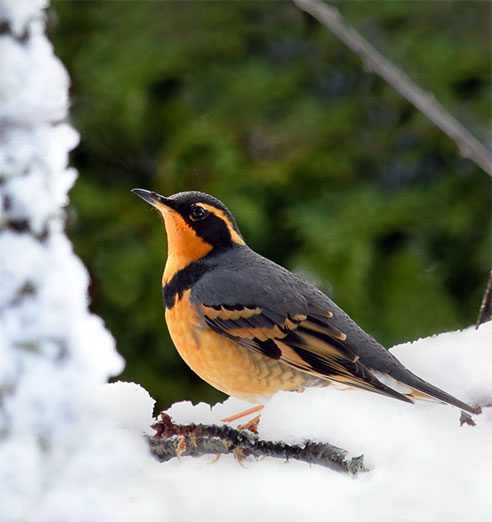
4. Varied Thrush
I waited all winter for this noble varied thrush to come close enough for a portrait. The bird skirted the edge of my property, just outside of camera range, searching for food. It wasn’t until a rare snowfall covered its feeding grounds that it came to see what I was serving at my feeders. —Sally Harris of Carlsborg, Washington
Attract with: hulled sunflower seeds in ground feeders, suet, fruit, mealworms
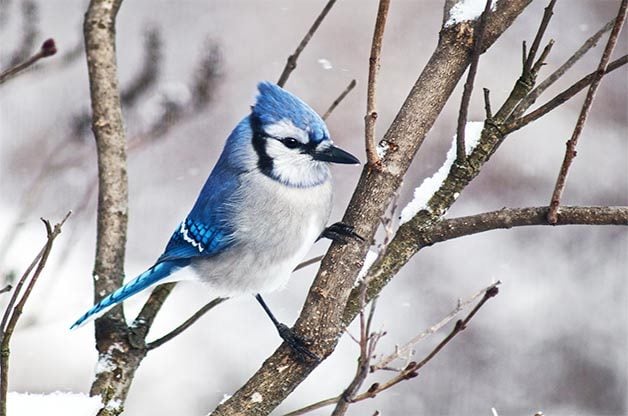
5. Blue Jay
Brilliantly colored blue jays are some of my favorite winter birds. This particular one looks like it’s trying to show off and say, “I’m going to pretend I don’t see you taking my picture, but here’s my good side.” —Noelle Sippel of Webster, New York
Attract with: peanuts, suet, sunflower seeds, fruit, plus oak trees and bird baths
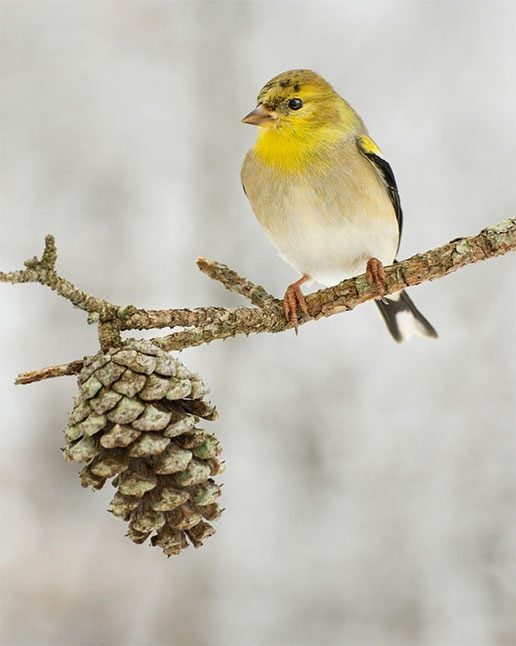
6. American Goldfinch
During the chilly months, American goldfinches travel in small flocks and dart around bird feeders. They also look for small seeds inside thistles, asters and native grasses. It’s fascinating to watch a male goldfinch transform from bright yellow to drab brown each year. —Matthew Cuda of Tobacoville, North Carolina
Attract with: black-oil sunflower seeds and thistle (nyjer) in finch feeders. Also add native thistle and milkweed plants to your yard.
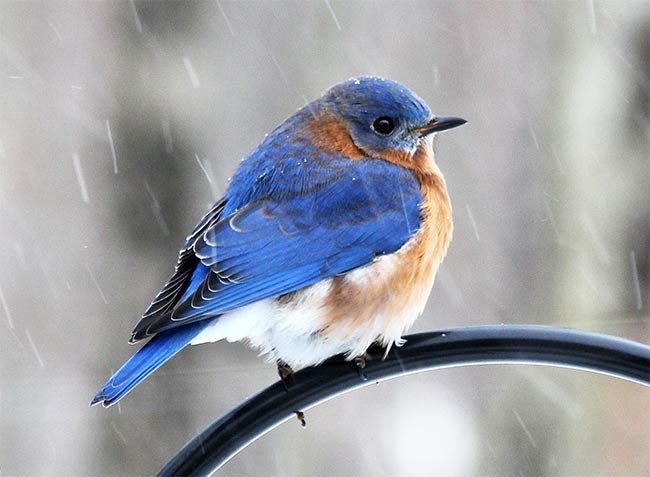
7. Eastern Bluebird
I captured this photo of a male eastern bluebird at the start of a winter storm. Cold weather creates some challenges for a bird’s survival, so I always do my best to provide the necessities—food, water and shelter. —Robert Merrifield of Amston, Connecticut
Attract with: mealworms or fruit in a platform feeder

8. Evening Grosbeak
The evening grosbeak is one of the most dramatic winter finches to come frm Canada to northeastern Minnesota’s coniferous forests. These colorful grosbeaks are a favorite at my feeders. Large flocks of them can be seen at the Sax-Zim Bog, which is north and west of Duluth. This species seems to have spread eastward about a century ago as box elder trees and other winter food sources became more plentiful. —Donald Kaddatz of Mora, Minnesota
Attract with: black-oil sunflower seeds in tube, hopper or platform feeders

9. Great Gray Owl
One morning, I heard crows cawing like crazy in my front yard. Knowing it meant a hawk or an owl was around, I ran outside in my housecoat and winter boots. Sure enough, a huge great gray owl flew across my driveway and landed on a fence post near the side of the road. I sat in a snowbank and took photos of it while it preened itself and stared right back at me. I love the intensity of its stare and the gorgeous patterns on its feathers. —Leslie Abram of Codrington, Ontario
Attract with: nest platforms in interior forests
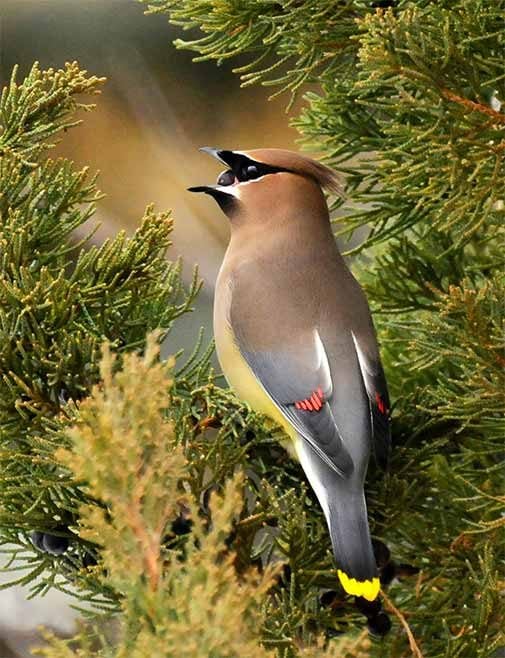
10. Cedar Waxwing
I watched this cedar waxwing munch on some berries on a cold December day at Frederik Meijer Gardens in Grand Rapids, Michigan. —Angela Rattinger of Fruitport, Michigan
Attract with: native, fruit-producing trees and shrubs, like serviceberry, juniper, hawthorn and winterberry
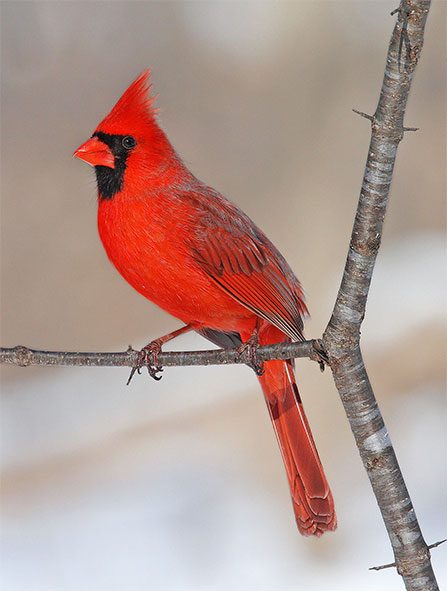
11. Northern Cardinal
On a below-zero day, I took this photo of a cardinal while I was in a blind at Camden State Park in southwest Minnesota. To attract these birds, I learned to mimic the cardinal call, and within minutes of me whistling, they came and landed near the black-oil sunflower seeds I put out. —Jon Wood of Marshall, Minnesota
Attract with: sunflower seeds, safflower, cracked corn, peanut hearts, backyard undergrowth and thickets for nesting
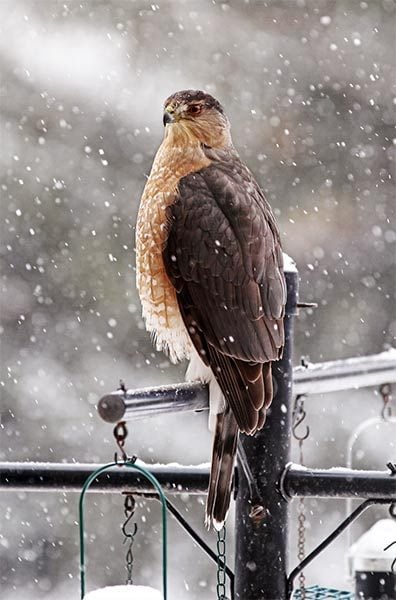
12. Cooper’s Hawk
A Cooper’s hawk stopped by our bird feeder last winter. All of the birds, squirrels and chipmunks quickly scattered. —Rodger Boehm of Winnetka, Illinois
Attract with: tree-filled habitats, forest edges
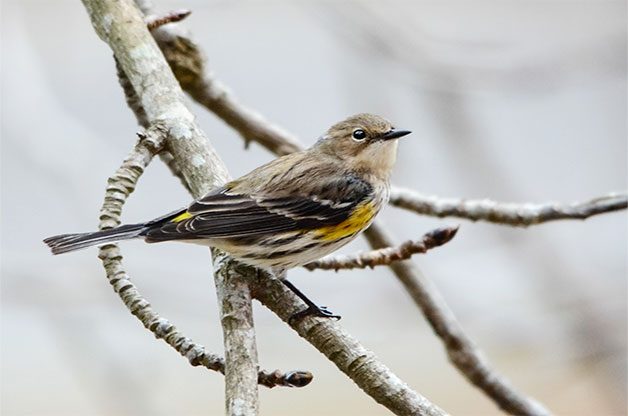
13. Yellow-Rumped Warbler
This is one of my favorite photographs of a yellow-rumped warbler. It was winter and there were no leaves on my trees. The bird hopped from branch to branch, posing for me before it flew away. —Betsy Moseley of Zellwood, Florida
Attract with: bayberry, Virginia creeper and other native fruiting shrubs and vines
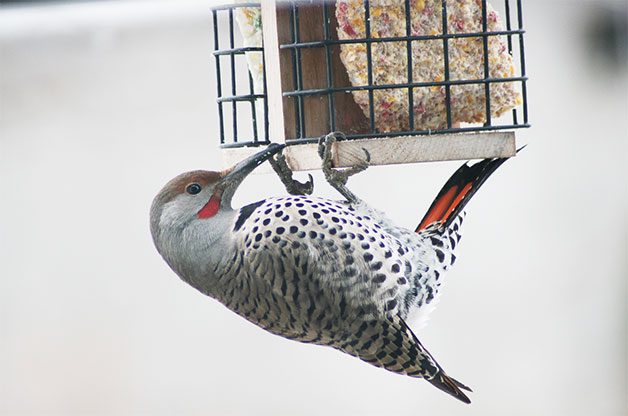
14. Northern Flicker
We love feeding and watching birds year-round at our home. Each winter, we are lucky to have the most colorful Northern flickers show up to gobble down the suet. —Karen Osadchey of Ridby, Idaho
Attract with: suet, safflower, peanuts, cracked corn
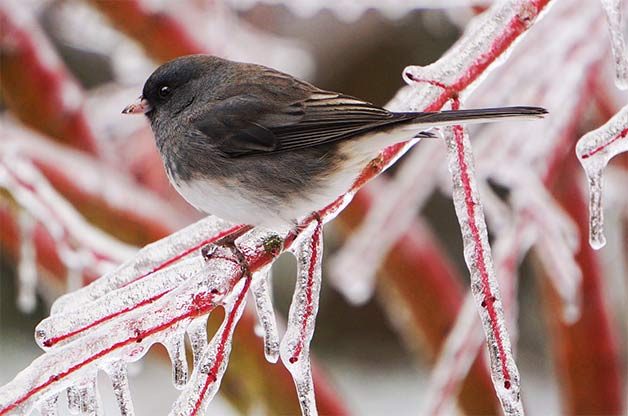
15. Dark-Eyed Junco
I see dark-eyed juncos almost daily in my backyard. Although I know they can be found on much of the continent, it seems as if they are all right here in North Carolina! The juncos mostly feed on the ground, but occasionally they fly to the feeders or use my little birdbath. I think they’re adorable! —Kimberly Miskiewicz of Raleigh, North Carolina
Attract with: black-oil sunflower seeds, peanut hearts, cracked corn, thistle, safflower seed
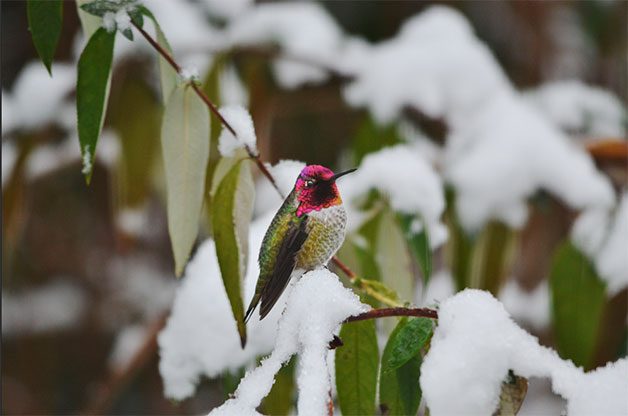
16. Anna’s Hummingbird
An Anna’s hummingbird spends winters in my yard. One day, I sat at the window waiting for the bird to light on the snow-covered butterfly bush. Eventually, the beautiful winter jewel obliged. —Kristi Gruel of Snohomish, Washington
Attract with: hummingbird sugar-water and nectar flowers
Winter Birding Festivals
From warm oases to frigid destinations, all corners of the United States offer a winter birding festival.
- Birds on the Niagara Buffalo area, New York
- Everglades Birding Festival Davie, Florida
- San Diego Bird Festival San Diego, California
- Space Coast Birding and Wildlife Festival Cape Canaveral, Florida
- Whooping Crane Festival Port Aransas area, Texas
- Winter Wings Festival Klamath Falls, Oregon
Please check festival websites for details and any COVID-19 updates.
Chickadee vs Junco

At first glance, dark-eyed juncos and chickadees can look quite similar. They’re around the same size and shape, their plumage includes shades of gray and white, and you might find both of them around bird feeders in your yard. But there are plenty of differences to help you become a master at correctly ID’ing these species—here’s how to tell a junco vs a chickadee apart.
Psst—here’s how to tell the difference between a nuthatch vs a chickadee.
Dark-Eyed Junco

If you see a speck of dark gray hopping around beneath your feeders in winter, chances are good that you’ve spotted a dark-eyed junco. These rosy-billed birds like to eat off the ground, dining on seed other birds have dropped or seeds from your native plants. They’ve been lovingly nicknamed “snowbirds” because they’re commonly sighted in winter throughout North America. While some stick around in spring on the Northeast, Northwest and California coasts, most head farther north to nest.
Find out how to attract more juncos to your backyard. While you’re at it, you might appreciate these adorable junco bird pictures, too.

Trademark junco traits include slate-gray upperparts and a white breast, as well as a pinkish-colored beak. Oregon juncos, commonly found in the West, have a chestnut-colored back and rust-colored plumage on their sides. Female dark-eyeds are usually a little larger than males, and their coloring strays closer to brown than that of their mate. Juvenile juncos are lighter-colored than the adults, and their plumage might have streaks.
Discover more cool facts about juncos.
Chickadee
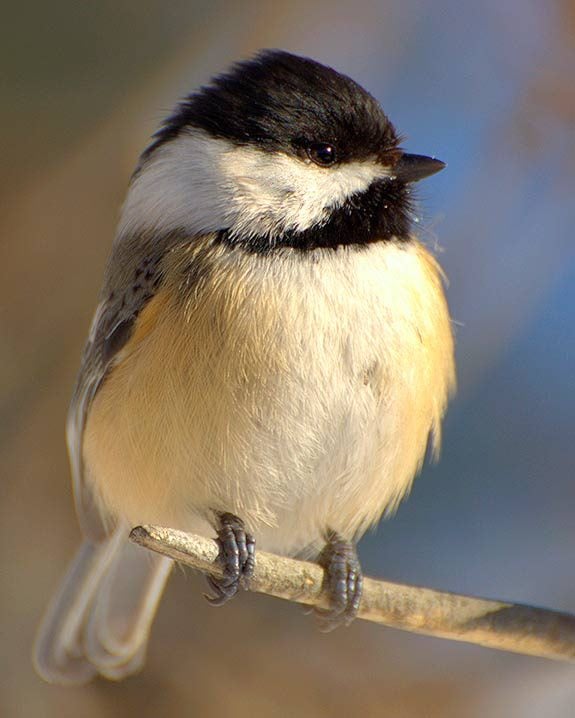
If you hear a chipper “chick-a-dee” song, that’s a chickadee announcing its presence! These perky backyard residents are frequently spotted at bird feeders, especially in winter—they don’t feed off the ground quite as frequently as juncos. You might also find them clinging to a dried seed-bearing flower in your garden, nibbling on the seeds. Unlike juncos, chickadees don’t migrate; you’ll be able to find them year-round.
Fans of the friendliest backyard fliers will love these incredibly cute chickadee pictures.
Several species of these cheery songbirds call North America their home, but based on their plumage, it’s not too hard to identify a junco vs a chickadee. Chickadees tend to have dark “caps” on their heads with white faces, and they also boast black bibs. In general, their coloring is typically a cloudy gray as compared to the dark-eyed junco’s slate black, and their breast is more cream-colored than the junco’s white. In addition, the chickadee’s beak is thinner and differs in color from the junco’s pink beak.
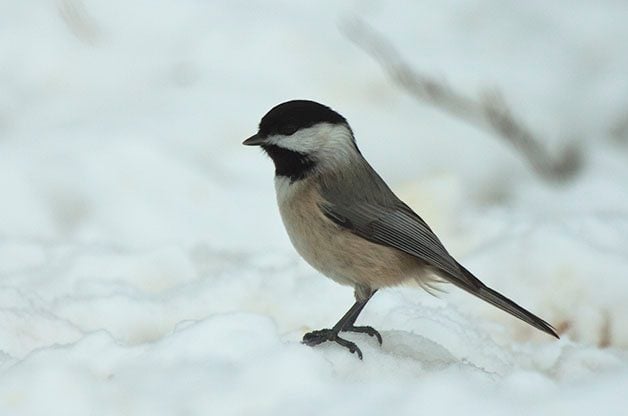
Depending on where you live, be on the lookout for the various types of chickadees in your backyard. Mountain chickadees (found in coniferous forests from Canada to Texas) feature a white stripe on their heads, while chestnut-backed chickadees (found along the Pacific coast) feature more brown on their backs than their largely gray relatives. Black-capped (found throughout most of North America) and Carolina chickadees (found in the Southeast and lower Midwest) look so similar they can be tough to tell apart.
The Mexican chickadee can only be found in the Chiricahua Mountains and the Animas Mountains, while the gray-headed chickadee is trickier to find still—it lives in Alaska’s Arctic Circle!
Next, discover the differences between downy and hairy woodpeckers.
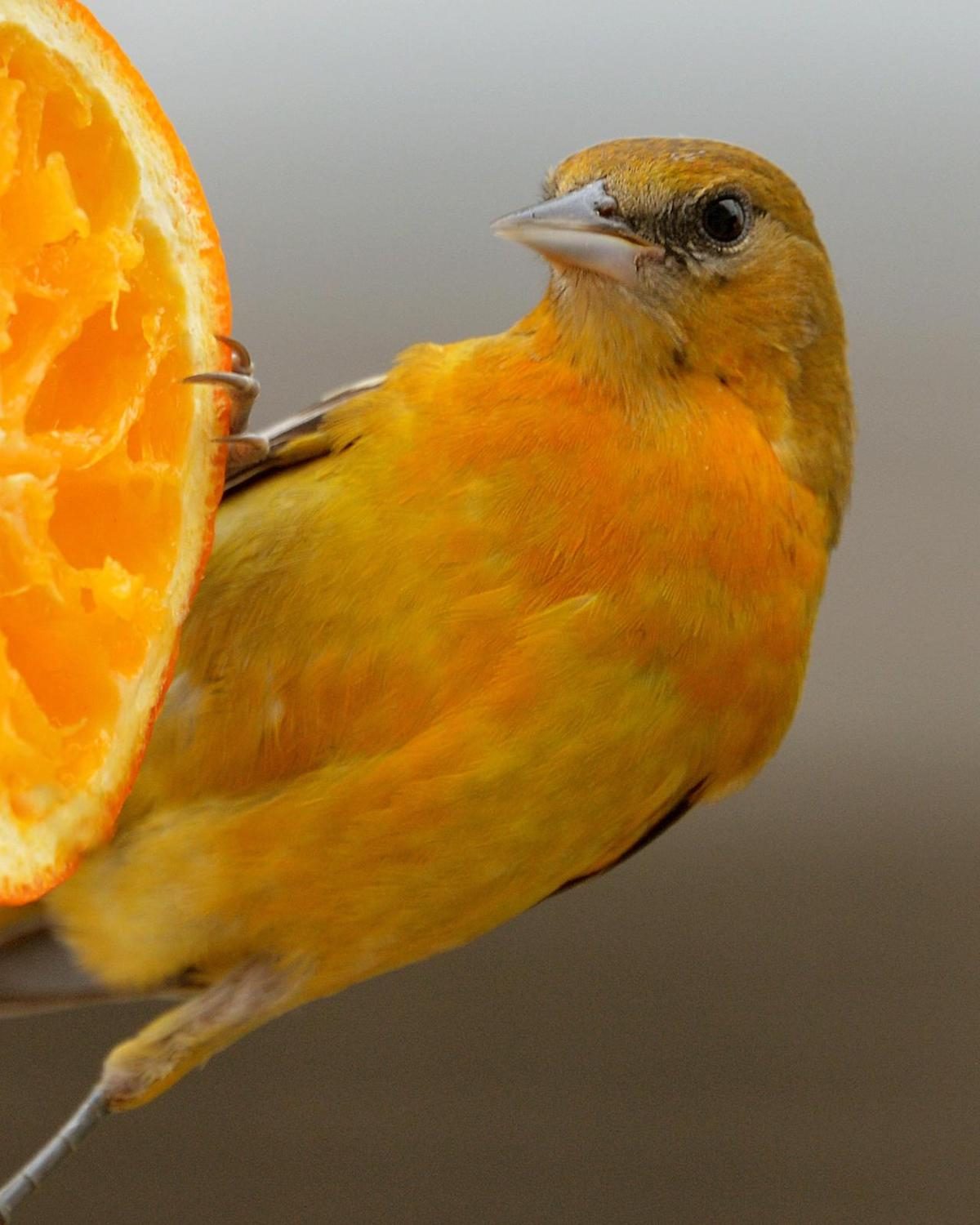
Do Baltimore Orioles Migrate in Winter?
“A Baltimore oriole visited our yard in November or December for the past three winters. It ate jelly, cut oranges, and seed from a ground feeder. I’m wondering about Baltimore oriole migration habits. Should that bird have been somewhere else?” asks Lori Ann O’Shaughnessy of Marlboro, New Jersey.
Yes, you’re right, most Baltimore orioles do migrate to the tropics—or at least to the subtropical edges of the southern United States—for the winter. But during the last couple of decades, increasing numbers have been staying through the winter in the states east of the Appalachians, from Georgia north to New England. The abundance of bird feeders in the region seems to have made the difference. In some Eastern states, people keep their oriole feeders up and filled with grape jelly and oranges to attract them. Apparently Baltimore orioles can survive cold winters as long as they find enough food.
Learn how to attract orioles to your backyard.

“Last December I saw a Baltimore oriole at my feeders. Is that normal?” Ronald Boucher of Rochester, Massachusetts, asks.
At one time, the answer would have been a flat no, because this oriole species usually flew to tropical or subtropical regions in fall. But in recent years, more and more Baltimore orioles have been spending the winter at feeders in the eastern states. Most of them are south of your area—many winter in the Carolinas, for example—but now some survive the season as far north as Massachusetts almost every winter. A few have been noticed even farther north, in Maine or parts of southern Canada. So your December visitor is rare, but not unprecedented.
If you’re looking for a Baltimore oriole in migration season or other times in the year, consider their favorite habitats. These birds prefer edges of deciduous forests, open grovers and parks and towns with lots of shade trees.